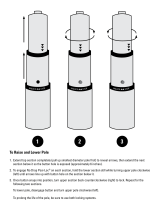
5
4. Do not perform any operation freehand. The
workpiece must be secured firmly against the turn
base and guide fence with the vise during all
operations. Never use your hand to secure the
workpiece.
5. Never reach around saw blade.
6. Turn off tool and wait for saw blade to stop
before moving workpiece or changing
settings.
7. Unplug tool before changing blade or
servicing.
8. Always secure all moving portions before
carrying the tool.
9. Stopper pin which locks the cutter head down
is for carrying and storage purposes only and
not for any cutting operations.
10. Do not use the tool in the presence of
flammable liquids or gases. The electrical
operation of the tool could create an explosion and
fire when exposed to flammable liquids or gases.
11. Check the blade carefully for cracks or
damage before operation.
Replace cracked or damaged blade
immediately.
12. Use only flanges specified for this tool.
13. Be careful not to damage the arbor, flanges
(especially the installing surface) or bolt.
Damage to these parts could result in blade
breakage.
14. Make sure that the turn base is properly
secured so it will not move during operation.
15. For your safety, remove the chips, small
pieces, etc. from the table top before
operation.
16. Avoid cutting nails. Inspect for and remove all
nails from the workpiece before operation.
17. Make sure the shaft lock is released before the
switch is turned on.
18. Be sure that the blade does not contact the
turn base in the lowest position.
19. Hold the handle firmly. Be aware that the saw
moves up or down slightly during start-up and
stopping.
20. Make sure the blade is not contacting the
workpiece before the switch is turned on.
21. Before using the tool on an actual workpiece,
let it run for a while. Watch for vibration or
wobbling that could indicate poor installation
or a poorly balanced blade.
22. Wait until the blade attains full speed before
cutting.
23. Stop operation immediately if you notice
anything abnormal.
24. Do not attempt to lock the trigger in the on
position.
25. Be alert at all times, especially during
repetitive, monotonous operations. Do not be
lulled into a false sense of security. Blades are
extremely unforgiving.
26. Always use accessories recommended in this
manual. Use of improper accessories such as
abrasive wheels may cause an injury.
27. Do not use the saw to cut other than wood,
aluminum or similar materials.
28. Connect miter saws to a dust collecting device
when sawing.
29. Select saw blades in relation to the material to
be cut.
30. Take care when slotting.
31. Replace the kerf board when worn.
32. Do not use saw blades manufactured from
high speed steel.
33. Some dust created from operation contains
chemicals known to cause cancer, birth
defects or other reproductive harm. Some
examples of these chemicals are:
• lead from lead-based-painted material and,
• arsenic and chromium from
chemically-treated lumber.
Your risk from these exposures varies,
depending on how often you do this type of
work. To reduce your exposure to these
chemicals: work in a well ventilated area
and work with approved safety equipment,
such as those dust masks that are
specially designed to filter out microscopic
particles.
34. To reduce the emitted noise, always be sure
that the blade is sharp and clean.
35. The operator is adequately trained in the use,
adjustment and operation of the machine.
36. Use correctly sharpened saw blades. Observe
the maximum speed marked on the saw blade.
37. Refrain from removing any cut-offs or other
parts of the workpiece from the cutting area
whilst the tool is running and the saw head is
not in the rest position.
38. Use only saw blades recommended by the
manufacturer which conform to EN847-1.
39. Wear gloves for handling saw blade (saw
blades shall be carried in a holder wherever
practicable) and rough material.
40. When fitted with laser, no exchange with
different type of laser is permitted. Repairs
shall only be carried out correctly.
SAVE THESE INSTRUCTIONS.





















